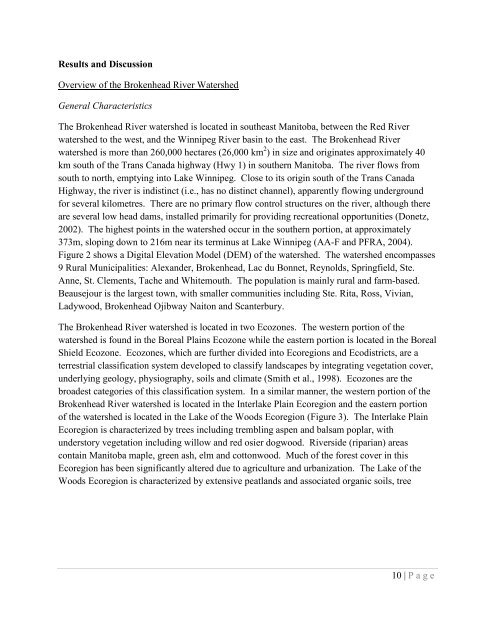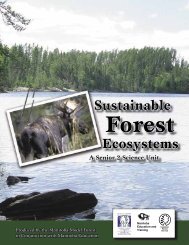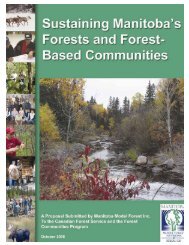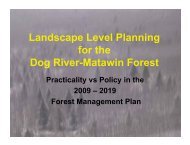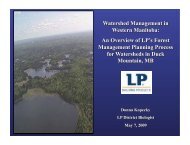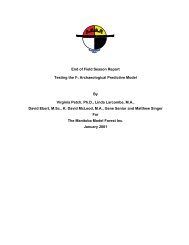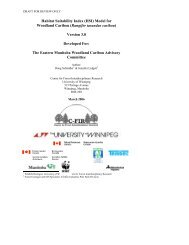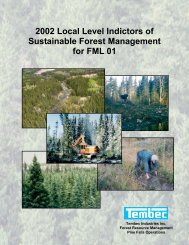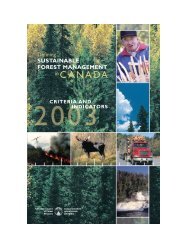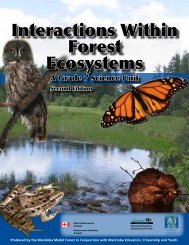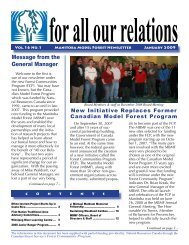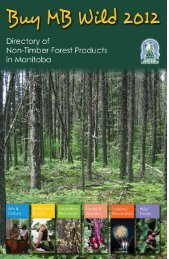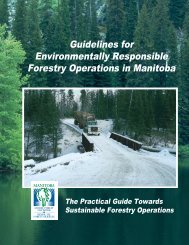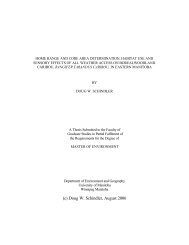Assessment of Water Quality in the Brokenhead River Watershed
Assessment of Water Quality in the Brokenhead River Watershed
Assessment of Water Quality in the Brokenhead River Watershed
You also want an ePaper? Increase the reach of your titles
YUMPU automatically turns print PDFs into web optimized ePapers that Google loves.
Results and Discussion<br />
Overview <strong>of</strong> <strong>the</strong> <strong>Brokenhead</strong> <strong>River</strong> <strong>Water</strong>shed<br />
General Characteristics<br />
The <strong>Brokenhead</strong> <strong>River</strong> watershed is located <strong>in</strong> sou<strong>the</strong>ast Manitoba, between <strong>the</strong> Red <strong>River</strong><br />
watershed to <strong>the</strong> west, and <strong>the</strong> W<strong>in</strong>nipeg <strong>River</strong> bas<strong>in</strong> to <strong>the</strong> east. The <strong>Brokenhead</strong> <strong>River</strong><br />
watershed is more than 260,000 hectares (26,000 km 2 ) <strong>in</strong> size and orig<strong>in</strong>ates approximately 40<br />
km south <strong>of</strong> <strong>the</strong> Trans Canada highway (Hwy 1) <strong>in</strong> sou<strong>the</strong>rn Manitoba. The river flows from<br />
south to north, empty<strong>in</strong>g <strong>in</strong>to Lake W<strong>in</strong>nipeg. Close to its orig<strong>in</strong> south <strong>of</strong> <strong>the</strong> Trans Canada<br />
Highway, <strong>the</strong> river is <strong>in</strong>dist<strong>in</strong>ct (i.e., has no dist<strong>in</strong>ct channel), apparently flow<strong>in</strong>g underground<br />
for several kilometres. There are no primary flow control structures on <strong>the</strong> river, although <strong>the</strong>re<br />
are several low head dams, <strong>in</strong>stalled primarily for provid<strong>in</strong>g recreational opportunities (Donetz,<br />
2002). The highest po<strong>in</strong>ts <strong>in</strong> <strong>the</strong> watershed occur <strong>in</strong> <strong>the</strong> sou<strong>the</strong>rn portion, at approximately<br />
373m, slop<strong>in</strong>g down to 216m near its term<strong>in</strong>us at Lake W<strong>in</strong>nipeg (AA-F and PFRA, 2004).<br />
Figure 2 shows a Digital Elevation Model (DEM) <strong>of</strong> <strong>the</strong> watershed. The watershed encompasses<br />
9 Rural Municipalities: Alexander, <strong>Brokenhead</strong>, Lac du Bonnet, Reynolds, Spr<strong>in</strong>gfield, Ste.<br />
Anne, St. Clements, Tache and Whitemouth. The population is ma<strong>in</strong>ly rural and farm-based.<br />
Beausejour is <strong>the</strong> largest town, with smaller communities <strong>in</strong>clud<strong>in</strong>g Ste. Rita, Ross, Vivian,<br />
Ladywood, <strong>Brokenhead</strong> Ojibway Naiton and Scanterbury.<br />
The <strong>Brokenhead</strong> <strong>River</strong> watershed is located <strong>in</strong> two Ecozones. The western portion <strong>of</strong> <strong>the</strong><br />
watershed is found <strong>in</strong> <strong>the</strong> Boreal Pla<strong>in</strong>s Ecozone while <strong>the</strong> eastern portion is located <strong>in</strong> <strong>the</strong> Boreal<br />
Shield Ecozone. Ecozones, which are fur<strong>the</strong>r divided <strong>in</strong>to Ecoregions and Ecodistricts, are a<br />
terrestrial classification system developed to classify landscapes by <strong>in</strong>tegrat<strong>in</strong>g vegetation cover,<br />
underly<strong>in</strong>g geology, physiography, soils and climate (Smith et al., 1998). Ecozones are <strong>the</strong><br />
broadest categories <strong>of</strong> this classification system. In a similar manner, <strong>the</strong> western portion <strong>of</strong> <strong>the</strong><br />
<strong>Brokenhead</strong> <strong>River</strong> watershed is located <strong>in</strong> <strong>the</strong> Interlake Pla<strong>in</strong> Ecoregion and <strong>the</strong> eastern portion<br />
<strong>of</strong> <strong>the</strong> watershed is located <strong>in</strong> <strong>the</strong> Lake <strong>of</strong> <strong>the</strong> Woods Ecoregion (Figure 3). The Interlake Pla<strong>in</strong><br />
Ecoregion is characterized by trees <strong>in</strong>clud<strong>in</strong>g trembl<strong>in</strong>g aspen and balsam poplar, with<br />
understory vegetation <strong>in</strong>clud<strong>in</strong>g willow and red osier dogwood. <strong>River</strong>side (riparian) areas<br />
conta<strong>in</strong> Manitoba maple, green ash, elm and cottonwood. Much <strong>of</strong> <strong>the</strong> forest cover <strong>in</strong> this<br />
Ecoregion has been significantly altered due to agriculture and urbanization. The Lake <strong>of</strong> <strong>the</strong><br />
Woods Ecoregion is characterized by extensive peatlands and associated organic soils, tree<br />
10 | P age


